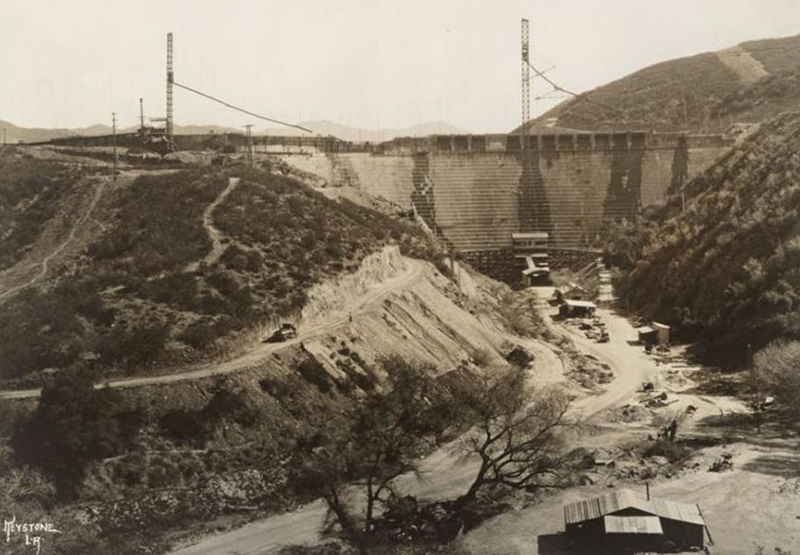|
|
1928 Dam Failure: A Vital Lesson for Today.
March 12, 2018.
|
Around midnight on March 12, 1928, just days after its reservoir was full for the first time, the St. Francis Dam failed catastrophically. In what many consider the worst civil engineering disaster of the 20th century, the resulting flood wave rampaged for more than five hours through the night, destroying thousands of acres of farmland, ripping apart a thousand structures, and cutting short more than 400 lives. Ninety years later, some lessons to be learned from the St. Francis Dam failure were echoed in the findings of the forensic investigation of the February 2017 spillway failure at Oroville Dam in California, reiterating the importance of learning from past failures.
The design and construction were supervised by the famous William Mulholland, a self-taught engineer who had risen through the ranks at the Los Angeles Department of Water and Power, starting as ditch cleaner. The St. Francis Dam, along with other projects such as the Los Angeles Aqueduct, was a part of Mulholland's lifelong work to quench Los Angeles' thirst as the city rapidly grew. When the St. Francis dam failed, high public and industry interest followed, along with more than a dozen forensic investigations. There was a consensus that numerous physical factors contributed such as instability of the dam foundations and abutments, and insufficient width of the dam base. Raising the height of the dam twice by 10 feet during construction without increasing its section thickness also contributed to the instability of the dam. While it is important to understand the mechanics of how the dam failed, these physical factors only tell part of the story. The lessons learned from this failure reside in the way these physical factors intersect with human judgments and decisions. The investigations revealed numerous significant "human factors" that contributed to the dam's failure throughout the design, construction, and maintenance of the dam:
As the entire nation reflected on the tragedy, immediate and obvious changes occurred in California law. The California legislature updated the dam safety program by eliminating the review exception that had been in place for municipalities like Los Angeles Water and Power, instead authorizing the state to have review authority for all non-federal dams in California. In 1929, a year after the failure, the state also created the state Board of Registration for civil engineers, to regulate the practice of civil engineering in California. "The St. Francis Dam failure was a pivotal event in U.S. history, in that it forced policymakers to consider their role in ensuring public safety through adequate oversight," said Jon Garton, president of the Association of State Dam Safety Officials. The recent spillway failure at Oroville Dam suggests that some of the lessons of the St. Francis Dam failure had been forgotten, or not sufficiently learned, decades after the failure. Factors common to both failures include overconfidence of individuals involved in design and construction, insufficient review of designs, missed warning signs, misunderstanding of site geology, and insufficient dissemination of state-of-practice technical knowledge within the dam engineering profession. "In both cases, the problem was not lack of sufficient knowledge collectively within the industry, but rather insufficient awareness and application of that knowledge," Garton said. "This highlights that there is a continued need today to learn from this failure." To learn more about the St. Francis Dam failure and see the schedule of 90th anniversary events, click here.
|
SEE ALSO:
Transcript of Coroner's Inquest
Hall of Justice 1928
Verdict of Coroner's Jury
Arizona Report 1928
Popular Science 1964
• Rippens Story of Dam Disaster (1998)
Vital Lesson for Today (ASDSO 2018)
At Dam Site 3-14-1928
With Van Norman at Dam Site 3-15-1928
Coroner's Jury Inspects 3/1928
Hall of Justice 1928
Fountain 1940s
Aqueduct Memorial Garden Opens at Mulholland Fountain: Story 10-23-2013
Mulholland Fountain & Aqueduct Garden: Photo Gallery 11-10-2013
|
The site owner makes no assertions as to ownership of any original copyrights to digitized images. However, these images are intended for Personal or Research use only. Any other kind of use, including but not limited to commercial or scholarly publication in any medium or format, public exhibition, or use online or in a web site, may be subject to additional restrictions including but not limited to the copyrights held by parties other than the site owner. USERS ARE SOLELY RESPONSIBLE for determining the existence of such rights and for obtaining any permissions and/or paying associated fees necessary for the proposed use.

 The St. Francis Dam, owned by the city of Los Angeles, was a 205-foot-tall concrete arched gravity dam which impounded about 38,000 acre-feet of water.
The St. Francis Dam, owned by the city of Los Angeles, was a 205-foot-tall concrete arched gravity dam which impounded about 38,000 acre-feet of water.















